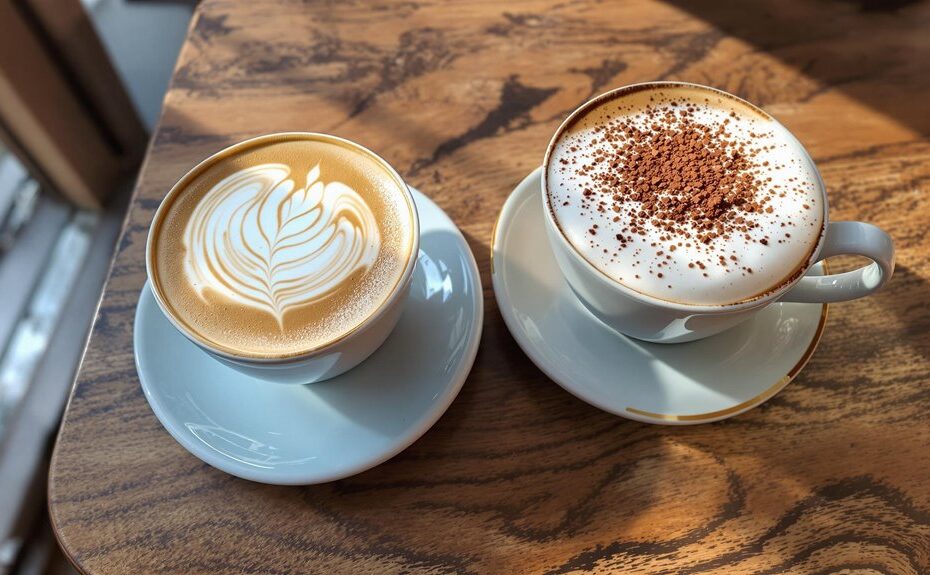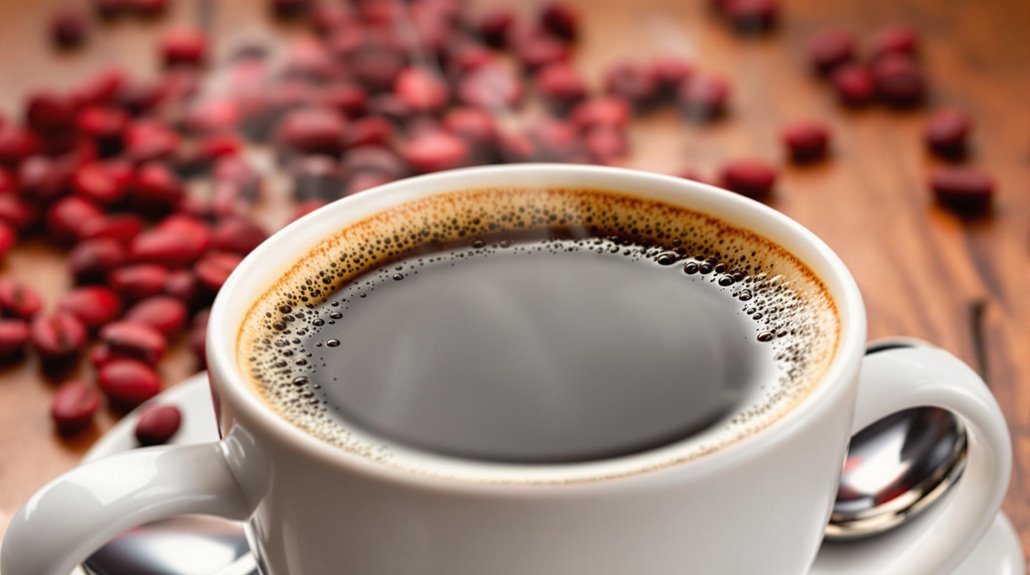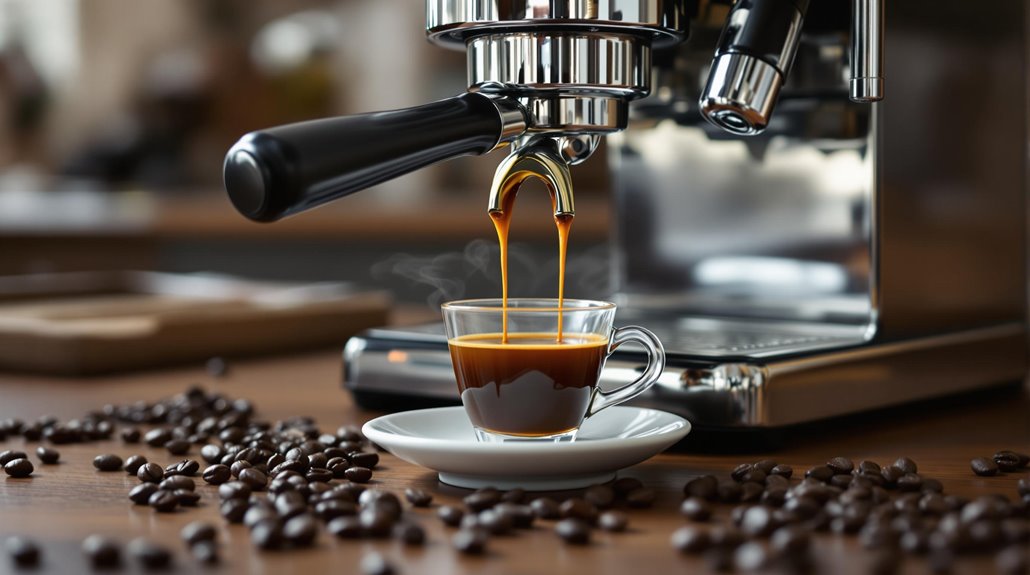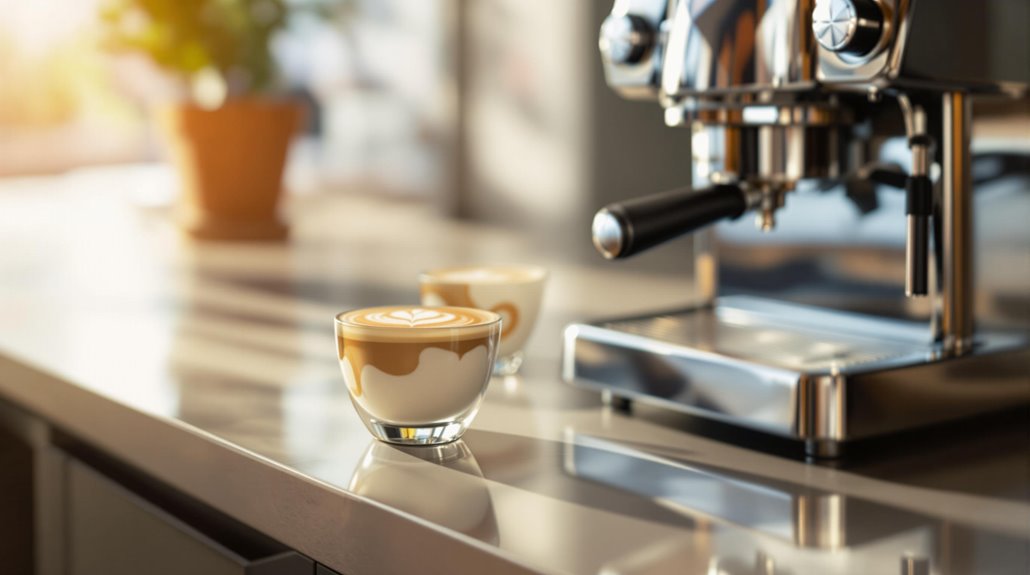







When you order a coffee, you might wonder what sets a latte apart from a cappuccino. Both drinks share a base of espresso, but their textures and flavors differ considerably. A latte's creaminess contrasts with the frothy boldness of a cappuccino, but that's just the beginning. Understanding the ingredients isn't enough; the historical and cultural contexts behind each drink also play an essential role in their popularity. So, what else should you know about these beloved beverages?
Key Takeaways
- A cappuccino consists of equal parts espresso, steamed milk, and foamed milk, while a latte has more steamed milk with a light foam layer.
- Cappuccinos have a stronger espresso flavor, whereas lattes are creamier and milder due to the higher milk content.
- The typical ratio for cappuccino is 1:1 of liquid to foam, while lattes follow a 1:2 ratio of espresso to steamed milk.
- Cappuccinos average 130 calories for a 12-ounce serving, making them lower in calories compared to lattes, which average 210 calories.
- Customization options for both drinks include flavored syrups and different milk types, enhancing personal preferences and flavor profiles.
Key Differences Between Latte and Cappuccino
When it comes to coffee, understanding the key differences between a latte and a cappuccino can elevate your café experience. At first glance, these two popular drinks might seem similar, but their compositions set them apart. A cappuccino consists of equal parts espresso, steamed milk, and foamed milk, creating a beautifully layered appearance. This balance results in a stronger espresso flavor, thanks to the higher foam content. In contrast, a latte features more steamed milk and just a light layer of foam, leading to a creamy, mixed texture with a milder taste.
The typical ratio in a cappuccino is 1-to-1 for liquid to foam, while a latte boasts a 1-to-2 ratio of espresso to steamed milk. If calories matter to you, keep in mind that a 12-ounce cappuccino averages around 130 calories, whereas the same size latte can hit approximately 210 calories. Additionally, lattes are often customized with flavored syrups, making them sweeter, while cappuccinos are usually enjoyed without any added sweeteners. Knowing these differences allows you to choose the right drink for your mood or taste preference.
Ingredients of Latte and Cappuccino
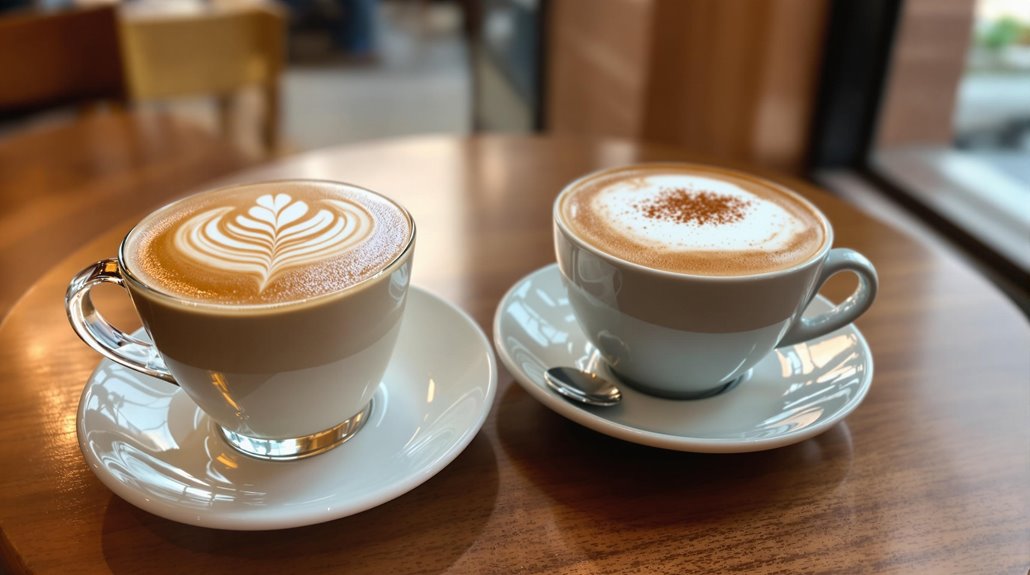
Understanding the ingredients that make up a latte and a cappuccino can enhance your appreciation of these beloved coffee drinks. Both beverages start with 1-2 shots of espresso, but the way they're prepared diverges considerably from there.
In a latte, you'll find several ounces of steamed milk combined with the espresso, giving it a creamy texture. It's topped off with a light layer of foamed milk, which adds a subtle richness without overwhelming the drink's flavor. The typical ratio for a latte is about 1 part espresso to 2 parts steamed milk, making it sweeter and smoother.
On the other hand, a cappuccino features an equal balance of espresso, steamed milk, and a thick layer of foamed milk. This 1-to-1 ratio creates a distinct layered appearance and results in a stronger espresso flavor. The foamed milk is denser, contributing to the cappuccino's texture and overall boldness.
Both drinks can be made with various types of milk, such as whole, skim, or alternatives, allowing you to customize the taste and texture to your preference. So, whether you're enjoying a latte or a cappuccino, you'll savor the unique blend of ingredients.
Health Benefits and Caloric Content

When you're choosing between a latte and a cappuccino, calorie content plays a significant role. A 12-ounce cappuccino typically packs around 130 calories, while the same size latte can hit about 210 calories due to its higher milk content. Understanding these differences can help you make a choice that aligns with your nutritional goals.
Caloric Comparison
Have you ever wondered why cappuccinos are often seen as the lighter choice compared to lattes? The caloric comparison between these two popular coffee drinks reveals that a 12-ounce cappuccino made with whole milk typically contains about 130 calories, while a latte of the same size clocks in at around 210 calories. This difference primarily stems from the amount of steamed milk used; lattes have considerably more milk, which contributes to their higher calorie count.
If you're trying to manage your calorie intake, cappuccinos present a compelling option. They generally have fewer calories than lattes, making them a preferred choice for those who want to enjoy a coffee beverage without overindulging. However, keep in mind that both drinks can be customized with non-fat or alternative milks, which can further affect their overall calorie counts.
Flavored lattes, often sweetened with syrups, can also spike their calorie content, making them less ideal for calorie-conscious consumers. So, when you're deciding between a cappuccino and a latte, consider not just your taste preference, but also how each drink fits into your dietary goals.
Nutritional Considerations
While both cappuccinos and lattes offer unique flavors and textures, their nutritional profiles can greatly impact your health choices. If you're watching your caloric intake, a cappuccino may be the better option. A 12-ounce cappuccino made with whole milk contains about 130 calories, while the same size latte boasts around 210 calories due to its higher steamed milk content.
For coffee drinkers who enjoy customizing their drinks, remember that the type of milk you choose can greatly alter the calorie count. Opting for skim or almond milk instead of whole milk can help reduce calories. Both drinks can be enhanced with flavored syrups, but keep in mind that these additions can quickly ramp up the overall calorie content, especially in lattes.
Although the nutritional differences may seem minimal, those seeking a stronger coffee flavor with fewer calories will likely favor cappuccinos. Ultimately, you can enjoy both beverages while making choices that align with your dietary preferences and health goals. Whether you prefer the lighter cappuccino or the creamier latte, being mindful of calories can help you savor your coffee experience without compromising your nutrition.
Popularity and Cultural Trends

As café culture has blossomed over the past two decades, lattes have taken center stage, enchanting coffee lovers with their creamy texture and endless customization options. This surge in popularity is largely due to the rise of artisanal coffee drinks, where the emphasis on quality and creativity reigns supreme. You can easily customize your latte with a variety of flavored syrups like vanilla or hazelnut, making each cup a unique experience tailored to your taste.
While cappuccinos gained traction during the World Wars and remain a classic choice for those who prefer a stronger espresso flavor, lattes shine with their versatility. The growing interest in latte art has also greatly contributed to their appeal. The visually stunning designs not only enhance your coffee experience but also make it Instagram-worthy, drawing attention on social media and fueling a broader interest in coffee culture.
As you scroll through your feeds, you'll notice how both lattes and cappuccinos are showcased, but it's the customized latte that often steals the spotlight. This blend of flavor, artistry, and personalization keeps lattes at the forefront of the coffee scene.
Home Brewing Techniques
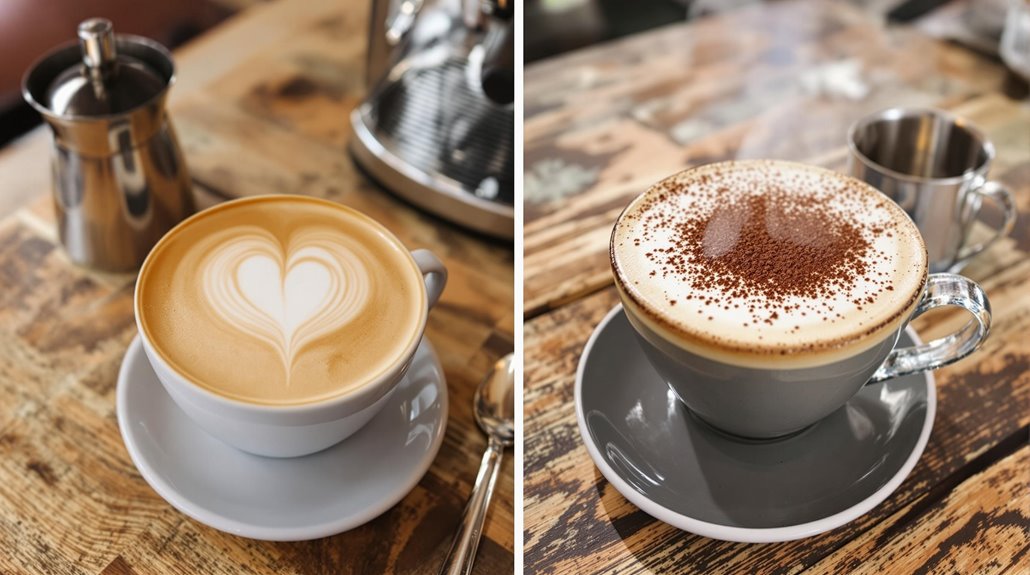
When it comes to home brewing, mastering the art of crafting lattes and cappuccinos can elevate your coffee experience to new heights. To brew a latte, start with 1-2 shots of espresso as the base. Next, steam about 8 ounces of milk until it reaches a creamy texture, then top it with a light layer of frothed milk for that perfect presentation.
For a cappuccino, you'll want to use the same 1-2 shots of espresso, but steam only about 4 ounces of milk, aiming for a thick foam layer that doubles the milk volume. This balance results in a delightful drink, combining equal parts espresso, steamed milk, and foam.
Using an electric milk frother can help you achieve the desired texture for both drinks. For cappuccinos, make sure the milk reaches a silky, melted marshmallow consistency. Don't hesitate to experiment with different milk types, like almond or oat milk, to find your ideal flavor and texture. Enhance your brewing skills by watching online tutorials focusing on espresso extraction and milk frothing techniques—these are essential for creating high-quality homemade lattes and cappuccinos.
Definitions of Latte and Cappuccino
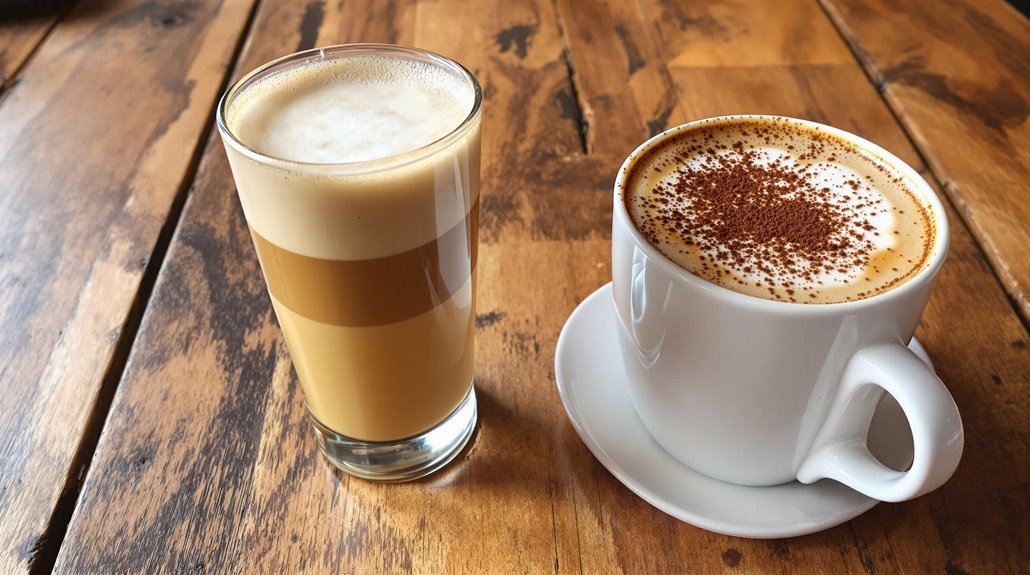
When you think about a latte, picture a creamy blend of espresso and steamed milk, topped with a light layer of foam. In contrast, a cappuccino showcases a striking balance of equal parts espresso, steamed milk, and thick foam, giving it a distinct layered look. Understanding these key differences in ingredients and preparation techniques can enhance your appreciation for each drink.
Key Ingredients Comparison
Latte and cappuccino, while both beloved espresso-based drinks, showcase distinct differences in their key ingredients and preparation methods. A latte typically consists of 1-2 shots of espresso mixed with several ounces of steamed milk, creating a creamy and smooth texture. It's topped with just a light layer of frothed milk, which allows the espresso flavor to blend beautifully with the milk's richness. This drink often invites customization with flavored syrups, making it a delightful option for those who enjoy a sweeter experience.
On the other hand, a cappuccino features the same 1-2 shots of espresso, but it's topped with equal parts steamed milk and a thick layer of foamed milk. This unique ratio creates a distinctly layered appearance and a stronger espresso flavor, appealing to purists who prefer a more robust taste without added sweeteners. Regarding caloric content, you'll find a 12-ounce cappuccino with whole milk has about 130 calories, while a 12-ounce latte clocks in around 210 calories. So, when choosing between the two, consider how you want your espresso experience to unfold!
Preparation Techniques Explained
Understanding the preparation techniques for lattes and cappuccinos reveals the artistry behind these popular espresso drinks. Both beverages start with the same base: a shot or two of rich espresso. However, the way you incorporate steamed milk and foam sets them apart.
For a latte, you'll want to combine 1-2 shots of espresso with several ounces of steamed milk. Pour the steamed milk into the espresso, creating a creamy texture that's smooth and cohesive. Finish with a light layer of foam on top, which adds a subtle contrast without overwhelming the drink.
In contrast, preparing a cappuccino requires equal parts espresso, steamed milk, and thick foamed milk. Here, you layer the components rather than mixing them. Pour the steamed milk over the espresso and then top it generously with foam, resulting in a distinct three-layer appearance. The typical ratio is 1-to-1 for liquid to foam, giving you that rich, frothy experience.
These preparation techniques not only influence the flavor profiles but also the textures of each drink, making them unique despite their shared foundation. Enjoy mastering the art of these espresso drinks!
Preparation Methods Explained
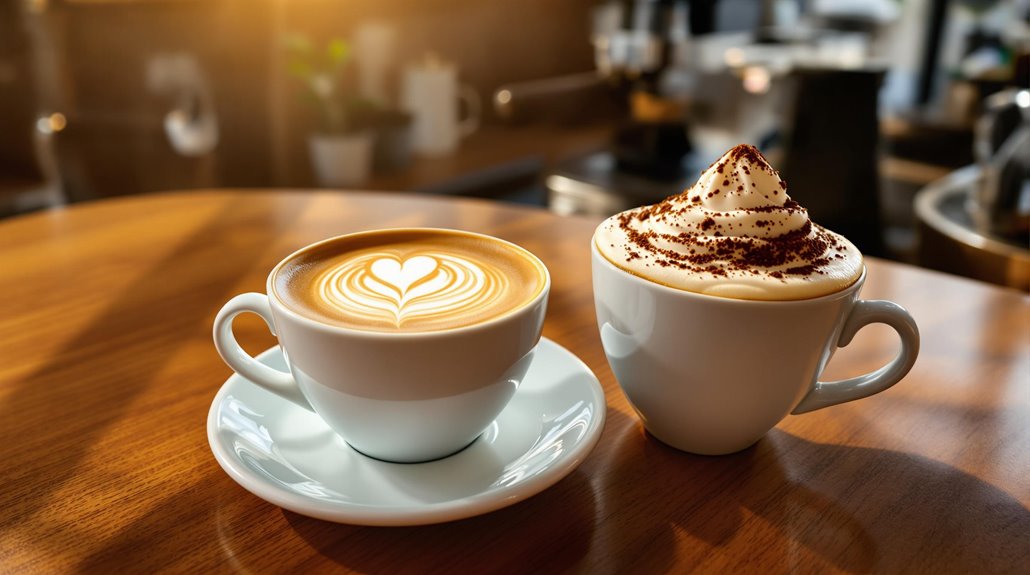
Two popular espresso-based drinks, lattes and cappuccinos, are crafted through distinct preparation methods that highlight their unique textures and flavors. The main difference lies in their milk-to-espresso ratios and the way the milk is steamed. For a latte, you start with 1-2 shots of espresso and combine them with several ounces of steamed milk, resulting in a creamier texture. To prepare it, steam the milk at a 45-degree angle for about 5 seconds, achieving a shiny, bubble-free consistency before pouring it over the espresso. You'll notice that a latte has more steamed milk, which softens the coffee's intensity.
In contrast, when making a cappuccino, you also begin with 1-2 shots of espresso, but then you top it with equal parts steamed milk and thick foamed milk. The steaming process for a cappuccino involves creating a volume that doubles, aiming for a texture reminiscent of melted marshmallow. This method creates a distinct layered appearance, with the frothy top enhancing the overall experience. By understanding these preparation methods, you can appreciate how each drink offers a unique flavor profile and texture.
Historical Origins of Both Drinks

When you sip a cappuccino, you're tasting a drink steeped in Italian tradition, named after the Capuchin friars whose robe color inspired its name. In contrast, the latte's journey began in Italy but truly blossomed in America during the 1980s, especially in coffee-loving Seattle. This evolution highlights how coffee culture can adapt and flourish across different regions, creating unique experiences for everyone.
Italian Coffee Heritage
Emerging from Italy's rich coffee culture, both the latte and cappuccino have fascinating historical origins that reflect the evolution of coffee itself. The cappuccino, deeply rooted in Italian coffee traditions, draws its name from the Capuchin friars, whose brown robes resemble the drink's color when mixed with milk. This delightful beverage gained popularity during the World Wars, becoming a staple in Italian cafés.
In contrast, the term "caffe latte" is believed to have first appeared in the United States in 1847, attributed to writer William Dean Howells. While "latte" simply means "milk" in Italian, the drink itself underwent significant transformation once it made its way across the Atlantic.
The espresso machine, patented by Luigi Bezzera in 1901, was pivotal in popularizing both drinks, allowing for a faster and richer coffee experience. The surge of Italian coffee shops in America during the late 20th century further shaped the way you enjoy these beverages today. Cappuccinos and lattes, while different in preparation and flavor, both celebrate the artistry of Italian coffee and its lasting impact on global café culture.
American Latte Evolution
Although the latte's roots trace back to Italian coffee culture, its evolution in America has transformed it into a beloved staple that reflects both local preferences and creativity. The modern latte, known for its creamy texture and larger milk volume, surged in popularity during the 1980s, especially in coffee-rich cities like Seattle. This shift highlighted Americans' love for rich, milky coffee drinks.
The term "latte" comes from the Italian phrase "caffè e latte," meaning coffee and milk. It first appeared in the U.S. in the 1940s, but it wasn't until the introduction of the espresso machine in 1901 by Luigi Bezzera that both lattes and cappuccinos gained traction. The espresso served as a strong base for these drinks, paving the way for a burgeoning coffee culture.
Meanwhile, cappuccinos, named after the Capuchin friars, retain their Italian essence, characterized by a balance of espresso, steamed milk, and froth. As the latte has evolved in America, it has embraced diverse flavor variations and presentation styles, showcasing a cultural exchange that continues to redefine how you enjoy your coffee.
Latte Art and Presentation Styles
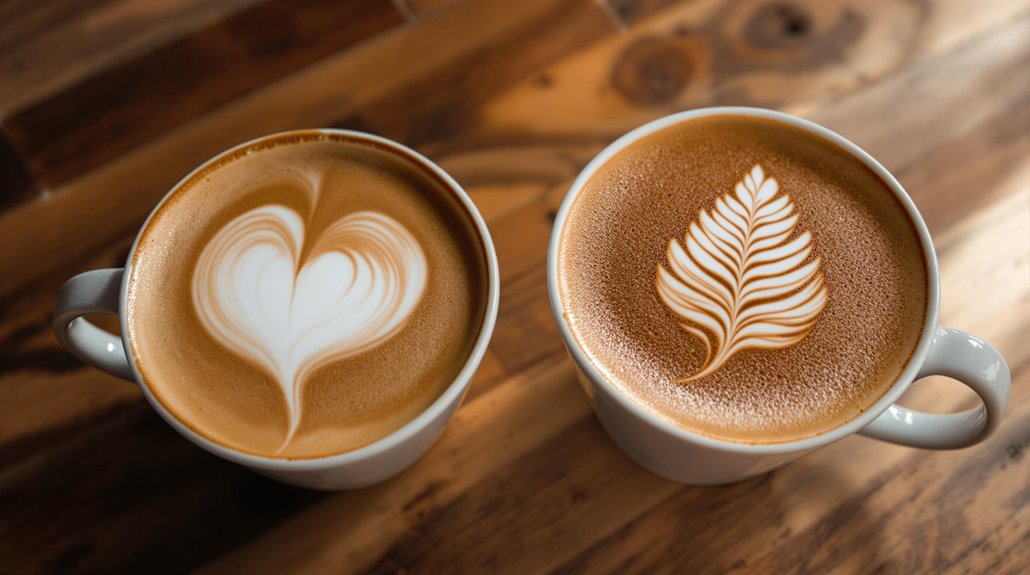
Latte art consistently captivates coffee enthusiasts, transforming a simple beverage into a canvas for creativity. When you pour steamed milk into a shot of espresso, you can create stunning designs that enhance the visual appeal of your latte. The smooth and creamy texture of the milk allows for intricate patterns, such as hearts, rosettas, and tulips. This contrasts sharply with cappuccinos, which typically feature a thicker foam layer that's less conducive to detailed designs.
The art of creating latte art has gained traction in coffee culture, with many baristas undergoing specialized training to refine their skills. The quality of the milk also plays a vital role; whole milk, with its higher fat content, froths beautifully and yields the best results for those delicate patterns. In contrast, cappuccinos are often presented with a simple dusting of cocoa or cinnamon, focusing more on flavor than artistry.
Whether you're a coffee novice or a seasoned aficionado, mastering the techniques behind latte art can elevate your coffee experience, making each cup not just a drink, but a work of art.
Variations and Customizations Available
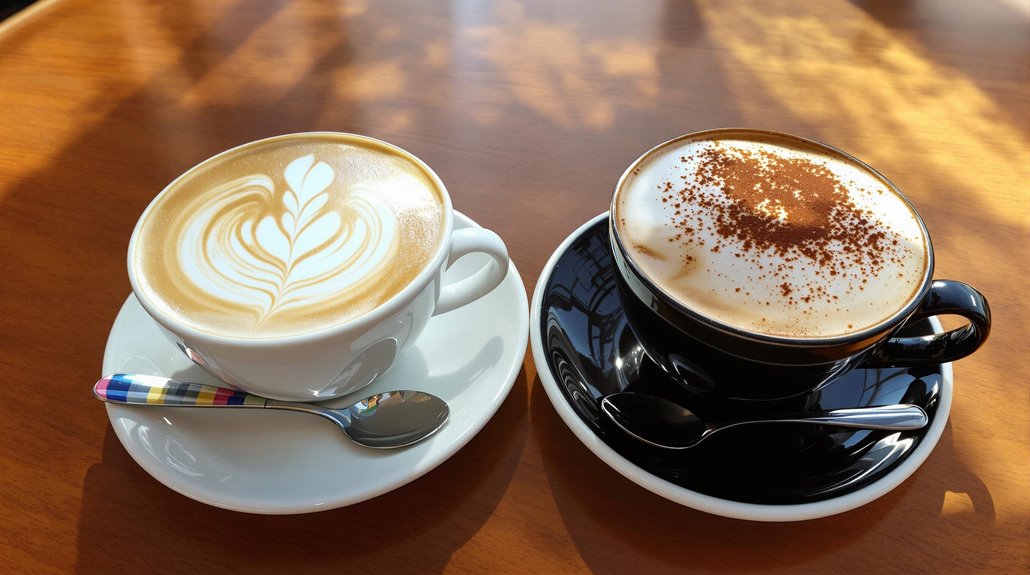
Exploring the myriad of variations and customizations available for lattes and cappuccinos can truly enhance your coffee experience. Both drinks offer a canvas for your creativity, allowing you to enjoy them just the way you like.
For lattes, you can easily customize your drink with flavored syrups like vanilla, hazelnut, or caramel to add sweetness and depth. You might also choose from a variety of milk options—whole, skim, almond, or oat—to tailor the flavor and texture to your preference. The milk's creaminess can greatly impact the overall experience, especially when it comes to the smooth, velvety foam that tops your latte.
Cappuccinos are a bit more straightforward but can still be jazzed up. While they're not typically flavored, you can sprinkle cocoa or cinnamon on top, giving your drink a delightful twist. Iced versions of both drinks are popular during warmer months, providing a revitalizing alternative. Non-dairy milk options can alter the taste and texture, catering to those with dietary restrictions or preferences. With these variations and customizations, your morning cup can be uniquely yours!
Disclosure: As an Amazon Associate, I earn from qualifying purchases.
